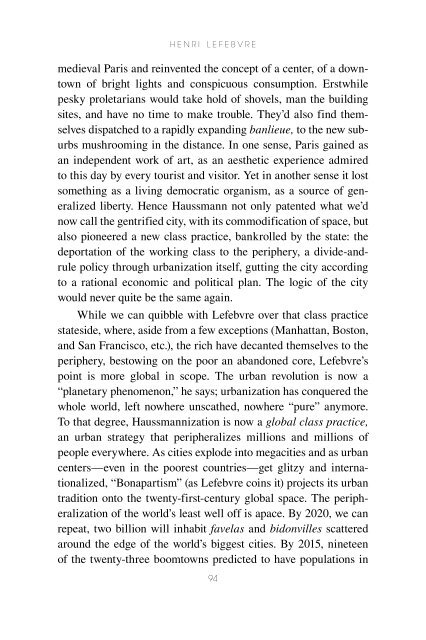Henri Lefebvre: A Critical Introduction - autonomous learning
Henri Lefebvre: A Critical Introduction - autonomous learning
Henri Lefebvre: A Critical Introduction - autonomous learning
You also want an ePaper? Increase the reach of your titles
YUMPU automatically turns print PDFs into web optimized ePapers that Google loves.
H e n r i L e F e b v r e<br />
medieval Paris and reinvented the concept of a center, of a downtown<br />
of bright lights and conspicuous consumption. Erstwhile<br />
pesky proletarians would take hold of shovels, man the building<br />
sites, and have no time to make trouble. They’d also find themselves<br />
dispatched to a rapidly expanding banlieue, to the new suburbs<br />
mushrooming in the distance. In one sense, Paris gained as<br />
an independent work of art, as an aesthetic experience admired<br />
to this day by every tourist and visitor. Yet in another sense it lost<br />
something as a living democratic organism, as a source of generalized<br />
liberty. Hence Haussmann not only patented what we’d<br />
now call the gentrified city, with its commodification of space, but<br />
also pioneered a new class practice, bankrolled by the state: the<br />
deportation of the working class to the periphery, a divide-andrule<br />
policy through urbanization itself, gutting the city according<br />
to a rational economic and political plan. The logic of the city<br />
would never quite be the same again.<br />
While we can quibble with <strong>Lefebvre</strong> over that class practice<br />
stateside, where, aside from a few exceptions (Manhattan, Boston,<br />
and San Francisco, etc.), the rich have decanted themselves to the<br />
periphery, bestowing on the poor an abandoned core, <strong>Lefebvre</strong>’s<br />
point is more global in scope. The urban revolution is now a<br />
“planetary phenomenon,” he says; urbanization has conquered the<br />
whole world, left nowhere unscathed, nowhere “pure” anymore.<br />
To that degree, Haussmannization is now a global class practice,<br />
an urban strategy that peripheralizes millions and millions of<br />
people everywhere. As cities explode into megacities and as urban<br />
centers—even in the poorest countries—get glitzy and internationalized,<br />
“Bonapartism” (as <strong>Lefebvre</strong> coins it) projects its urban<br />
tradition onto the twenty-first-century global space. The peripheralization<br />
of the world’s least well off is apace. By 2020, we can<br />
repeat, two billion will inhabit favelas and bidonvilles scattered<br />
around the edge of the world’s biggest cities. By 2015, nineteen<br />
of the twenty-three boomtowns predicted to have populations in<br />
94
















